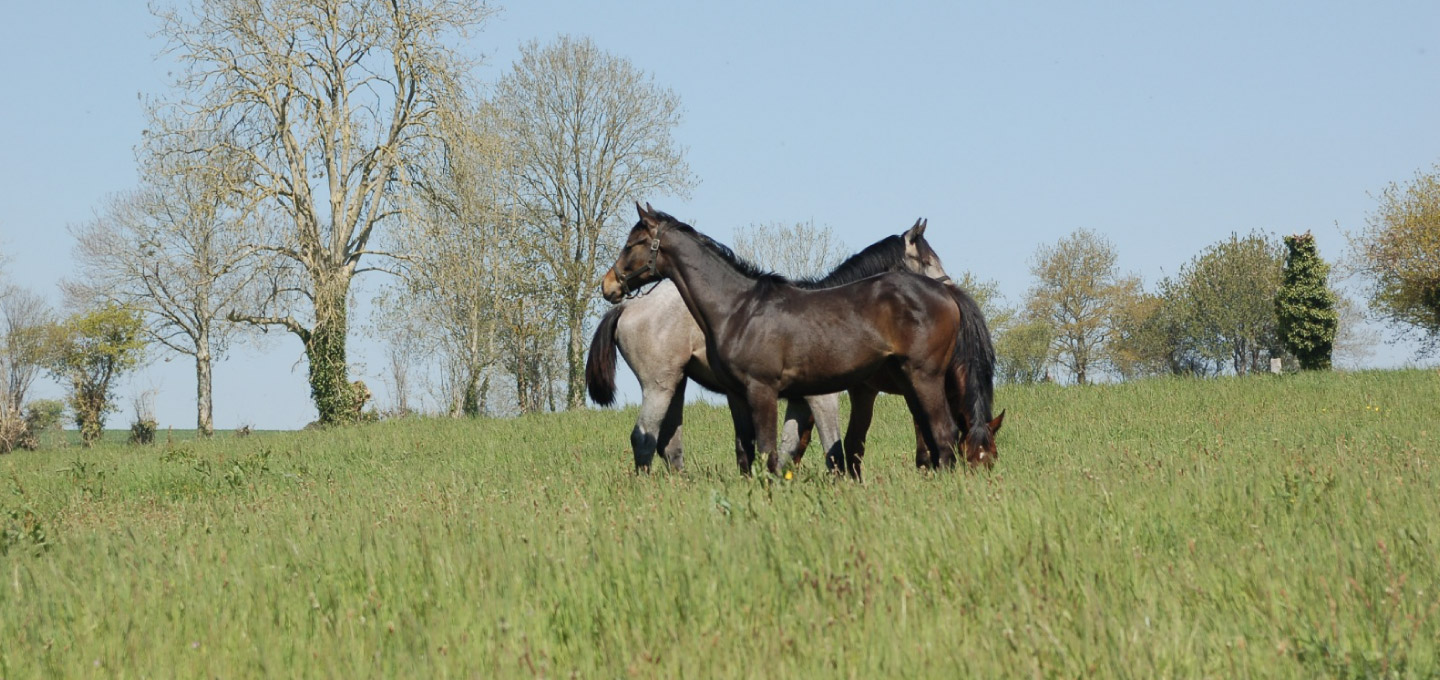SUMMARY
What are the factors that influence the amount of sugar in grass?
What are the factors that influence the amount of sugar in grass?
As the horse is a herbivore, grazing is an important element: for his mental well-being (keeps him occupied and reduces boredom) and for his health (allows him to walk around throughout the day and meet his daily energy requirements).
However, grazing can also prove be problematic, especially when sugar levels in grass are too high. In temperate latitudes, grass stores its energy in the form of fructans, which are polymers of fructose that are not broken down by the enzymatic system of the small intestine, but are easily fermented by the lactate-producing bacteria of the large intestine.
Therefore, ingesting too many fructans will lead to undesirable fermentations, associated with an acidification of the pH of the large intestine, as well as the release of bacterial toxins.
These alterations are responsible for the development of colic and/or laminitis in horses at grass, particularly in the spring and autumn.
Why are these disorders mainly seasonal when horses are out at grass? Are there better moments than others to turn your horse out to grass?
A study was undertaken in the Piedmont region of Virginia in the USA. The weather in this region is temperate, with average temperatures and hours of sunshine being similar to those seen in the South of France, while rainfall is closer to that observed the West, although with a higher peak in the summer months. The authors studied the levels of soluble sugars in orchard-grass pasture according to the month of the year as well as the time of day. To do this, they collected grass samples every week between April and June, in the morning (between 8 and 10 am) as well as in the afternoon (between 4 and 5 pm).
As a result, they observed that the concentration of soluble sugars (fructans + glucose + fructose + saccharose) was higher in April than in May and June, that is to say just before an important period of growth in the grass, combined with an increase in temperatures. In anticipation of growth, grass stores energy in the form of fructans. Once temperatures rise, growth starts and the grass uses its resources, which explains the drop between April and May. The evolution of soluble sugar concentrations also runs parallel to that of fructans. This means that the risk of laminitis is highest in early spring and decreases with the arrival of summer and the growth of the grass. What is observed in spring is also observed in autumn, which is why these two seasons are associated with a higher number of cases of laminitis.
This difference is also observed between the morning and the afternoon: the grass is richer in soluble sugars at the end of the day. Thanks to photosynthesis, grass will produce and store sugars in simple forms (glucose, fructose, saccharose) or polymerised (fructans) during the day. It will use these reserves at night to continue growing, despite the absence of light. It is therefore advisable to graze horses at risk in the morning when sugars levels are lowest. However, beware of the ability of horses to increase their intake of grass when they know they are restricted, which may lead them to ingest a bigger quantity of sugar, despite the lower levels in the grass in the morning, and therefore be at an increased risk of developing laminitis.
Therefore, it is best to turn at-risk horses out to grass with a grazing muzzle to limit grass intake. It is also important to offer the horse hay in the field, despite the presence of grass. This is true as long as night temperatures are high (> 15°C), however when they drop (< 10°C), nocturnal growth slows down or even stops. The grass no longer uses all its sugar reserves at night, so it accumulates more soluble sugars than it uses: this also explains why the risk of laminitis is greater in the spring and the autumn.
Finally, the authors observed that hay made in these pastures was no less rich in sugar than fresh grass. This means that hay can also be very high in sugar, and that it is therefore necessary to soak it for at least 2 hours before feeding it to horses who are at-risk (overweight, insulin resistant, suffering from equine metabolic syndrome or Cushing's disease).
It is also important to know that sugar reserves are found at the base of the stem, and that the quantity of soluble sugar increases when it is very sunny, when there is a lack of water, when soil is lacking organic matter, when it freezes but the weather is fine or when pasture is overgrazed. On the other hand, it decreases on days with little sunshine and varies according to the species sown and/or naturally occurring in the fields, but also in varieties within certain species.
Source
I Kagan, B Kirch, C Thatcher, J Strickland, C Teutsch, F Elvinger, R Pleasant (2011). Seasonal and diurnal variation in simple sugar and fructan composition of orchardgrass pasture and hay in the Piedmont region of the United States.




